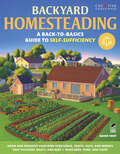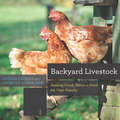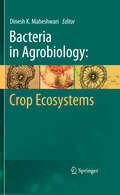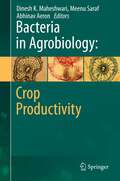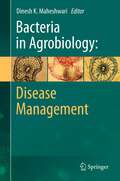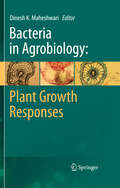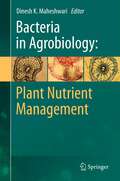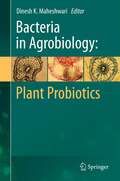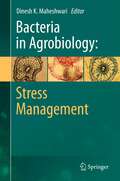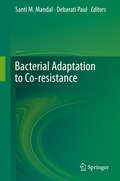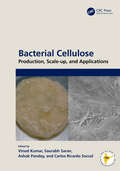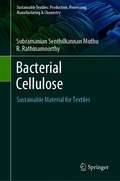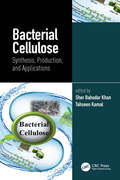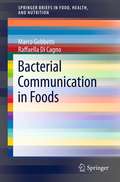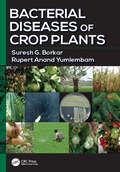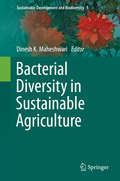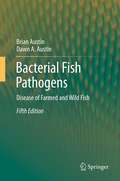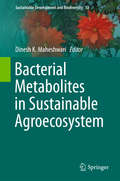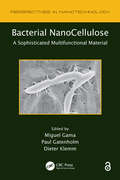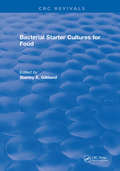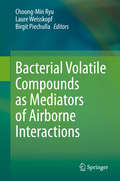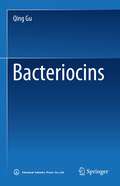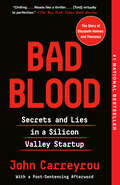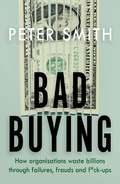- Table View
- List View
Backyard Homesteading: A Back-to-Basics Guide to Self-Sufficiency (Gardening Ser.)
by David TohtA simple guide to growing fruits, vegetables, nuts & berries, raising chickens, goats, & bees, and making beer, wine, & cider from your backyard.If you want to take control of the food you eat and the products you use, Backyard Homesteading will help you learn how to do it—even if you live in an urban or suburban house on a typical-size lot. Inside, you’ll discover how to turn a yard into a productive and wholesome “homestead” that allows you to grow your own fruits and vegetables and raise farm animals, including chickens and goats. You’ll also find the laws and regulations of raising livestock in populated areas, as well as ways to use and preserve the bounty your land produces.GETTING STARTEDBenefits of pure foodFamily recreationLocal regulationsPotential yields and savingsRAISING VEGETABLES AND HERBSGarden planning/layoutStructures/irrigationVegetable profilesPlanting techniquesComposting/healthy soilSeasonal gardeningGROWING FRUITS, BERRIES, AND NUTSPlanting fruit trees and bushesFruit profilesOrganic pest controlGrafting and pruningHarvesting methodsRAISING CHICKENSThe joy of chickensCollecting eggsCare and feeding tipsOther small animalsRAISING GOATSBenefits of goat milkStructures/fencingCare and feeding tipsOther large animalsBEEKEEPINGBenefits of beekeepingCare and harvestingBuilding hivesCollecting honeyHARVEST HOMECanning/drying/freezingMaking beer, wine, ciderMaking jerky, sausageMaking jams, jelliesPickling/salting/smokingBuilding root cellars
Backyard Livestock: Raising Good, Natural Food For Your Family (Countryman Know How #0)
by Steven Thomas George B. LoobyA new edition of the essential guide to animal husbandry Have you ever celebrated Thanksgiving with a turkey from a local farm, instead of a packaged, frozen supermarket bird? Ever cracked a farm-fresh egg into the skillet next to a store-bought one? The difference in quality can’t be overstated. Small-scale livestock farming not only brings better, safer, and more delicious food to your table, but it can do so economically. Long the primary reference for anyone who keeps animals as a sustainable food source, this latest edition comes with a beautiful new design and includes up-to-date information on breeding, feeding, disease prevention, housing, and management. Complete with clarifying diagrams, full color photography, and a catalog of supplemental reading, Backyard Livestock continues to be the best resource for those who wish to sustainably and ethically raise their own farm-fresh food.
Bacteria in Agrobiology: Crop Ecosystems
by Dinesh K. MaheshwariThe future of agriculture strongly depends on our ability to enhance productivity without sacrificing long-term production potential. An ecologically and economically sustainable strategy is the application of microorganisms, such as the diverse bacterial species of plant growth promoting bacteria (PGPB). The use of these bio-resources for the enhancement of crop productivity is gaining worldwide importance. Bacteria in Agrobiology: Crop Ecosystems describes the beneficial role of plant growth promoting bacteria with special emphasis on oil yielding crops, cereals, fruits and vegetables. Chapters present studies on various aspects of bacteria-plant interactions, soil-borne and seed-borne diseases associated with food crops such as rice, sesame, peanuts, and horticultural crops. Further reviews describe technologies to produce inoculants, the biocontrol of post harvest pathogens as a suitable alternative to agrochemicals, and the restoration of degraded soils.
Bacteria in Agrobiology: Crop Productivity
by Dinesh K. Maheshwari Abhinav Aeron Meenu SarafThe future of agriculture greatly depends on our ability to enhance productivity without sacrificing long-term production potential. The application of microorganisms, such as the diverse bacterial species of plant growth promoting rhizobacteria (PGPR), represents an ecologically and economically sustainable strategy. The use of these bio-resources for the enhancement of crop productivity is gaining importance worldwide. Bacteria in Agrobiology: Crop Productivity focus on the role of beneficial bacteria in crop growth, increased nutrient uptake and mobilization, and defense against phytopathogens. Diverse group of agricultural crops and medicinal plants are described as well as PGPR-mediated bioremediation leading to food security.
Bacteria in Agrobiology: Disease Management
by Dinesh K. MaheshwariThe future of agriculture greatly depends on our ability to enhance productivity without sacrificing long-term production potential. The application of microorganisms, such as the diverse bacterial species of plant growth promoting bacteria (PGPB), represents an ecologically and economically sustainable strategy. The use of these bio-resources for the enhancement of crop productivity is gaining importance worldwide. "Bacteria in Agrobiology: Disease Management" discusses various aspects of biological control and disease suppression using bacteria. Topics covered include: fluorescent pseudomonads; siderophore-producing PGPR; pseudomonas inoculants; bacillus-based biocontrol agents; bacterial control of root and tuber crop diseases; fungal pathogens of cereals; soil-borne fungal pathogens; peronosporomycete phytopathogens; and plant parasitic nematodes.
Bacteria in Agrobiology: Plant Growth Responses
by Dinesh K. MaheshwariThe future of agriculture strongly depends on our ability to enhance productivity without sacrificing long-term production potential. An ecologically and economically sustainable strategy is the application of microorganisms, such as the diverse bacterial species of plant growth promoting bacteria (PGPB). The use of these bio-resources for the enhancement of crop productivity is gaining worldwide importance. "Bacteria in Agrobiology: Plant Growth Responses" describes the application of various bacteria in plant growth promotion and protection, including symbiotic, free living, rhizospheric, endophytic, methylotrophic, diazotrophic and filamentous species.
Bacteria in Agrobiology: Plant Nutrient Management
by Dinesh K. MaheshwariThe future of agriculture strongly depends on our ability to enhance productivity without sacrificing long-term production potential. An ecologically and economically sustainable strategy is the application of microorganisms, such as the diverse bacterial species of plant growth promoting bacteria (PGPB). The use of these bio-resources for the enhancement of crop productivity is gaining worldwide importance. "Bacteria in Agrobiology: Plant Nutrient Management" focus on the management of plant nutrient to support plant growth and development. The topics treated in this book include mechanisms of plant growth promoting rhizobacteria, zinc and phosphate solubilizing microorganisms, sulfur oxidizing bacteria, ACC deaminase, siderophores, phytohormones, quorum-sensing, biofilms, antibiotics, volatiles, denitrification and integrated nutrient management.
Bacteria in Agrobiology: Plant Probiotics
by Dinesh K. MaheshwariThe future of agriculture strongly depends on our ability to enhance productivity without sacrificing long-term production potential. An ecologically and economically sustainable strategy is the application of microorganisms, such as the diverse bacterial species of plant growth promoting bacteria (PGPB). The use of these bio-resources for the enhancement of crop productivity is gaining worldwide importance. "Bacteria in Agrobiology: Plant Probiotics" discusses the current trends and future prospects of beneficial microorganisms acting as Probiotics. Topics include the application for the aboveground fitness of plants, in mountain ecosystems, in tropical and Mediterranean forests, and in muga sericulture. Further aspects are Arabidopsis as a model system for the diversity and complexity of plant responses, plant parasitic nematodes, nitrogen fixation and phosphorus nutrition.
Bacteria in Agrobiology: Stress Management
by Dinesh K. MaheshwariThe future of agriculture strongly depends on our ability to enhance productivity without sacrificing long-term production potential. An ecologically and economically sustainable strategy is the application of microorganisms, such as the diverse bacterial species of plant growth promoting bacteria (PGPB). The use of these bio-resources for the enhancement of crop productivity is gaining worldwide importance. "Bacteria in Agrobiology: Stress Management" covers the major aspects on PGPR in amelioration of both abiotic and biotic stresses. PGPR mediated in priming of plant defense reactions, nutrient availability and management in saline and cold environment, hormonal signaling, ACC deaminase and its role in ethylene regulation under harsh conditions are suitably described.
Bacterial Adaptation to Co-resistance
by Santi M. Mandal Debarati PaulThe proposed book aims to understand the mechanism of survival of microorganisms in response to chemical stress in various ecological niches that suffer direct human intervention, more so the agricultural, domestic and hospital settings. Microbicides (e.g. disinfectants, antiseptics, fungicides, algaecides, insecticides and pesticides) are used rampantly to control undesirable microbes. Insecticides and pesticides are routinely used in agriculture which directly affect the microbial population in farms, orchards and fields. Health care environments are always stressed with disinfectants and antibiotics. It is always probable that microbicide-stressed microorganisms are in a dynamic state, displaced from one niche to the other. Some soil and water borne bacteria or their resistance determinants are also getting prominence in hospital settings after suffering selective pressure from agricides. In order to reveal the survival strategies of microbicidal-resistant microbes, it is of prime importance to know the mode of action of these complete range of microbicides (agricides to antibiotics). The present book intends to address these issues. There will be several chapters dealing with tolerance and cross resistance in microbes and bacteria in particular, dwelling in various niches. Till date, there is no consensus among scientists in theorizing molecular mechanisms to explain bacterial tolerance and their cross resistance to agricides and antibiotics.
Bacterial Cellulose: Production, Scale-up, and Applications
by Vinod Kumar Carlos Ricardo Soccol Ashok Pandey Saurabh SaranThis reference book provides updated information on the production and industrial significance of bacterial cellulose. Bacterial cellulose is a natural fiber produced by certain microbes, mainly bacteria which belong to the Acetobacter genera. The book discusses its applications in different industrial sectors, such as food, pharmaceutical, energy, and wastewater treatment. It covers the production of cellulose from conventional and renewable feedstock and includes topics such as downstream processing, characterization, and chemical modification of bacterial cellulose. FEATURES Addresses the challenges of the production technologies of bacterial cellulose up to pilot scale Discusses cost-effective green processes using agri-processing residues and medium formulation Includes efficient preparation of nanocomposites using in vitro and in vivo methods Provides the latest applications of bacterial cellulose in the food and pharmaceuticals fields Reviews the production of bacterial cellulose from conventional feedstock such as sugars and starches This book is designed for industry experts and researchers of applied microbiology, bioprocesses, and industrial microbiology.
Bacterial Cellulose: Sustainable Material for Textiles (Sustainable Textiles: Production, Processing, Manufacturing & Chemistry)
by Subramanian Senthilkannan Muthu R. RathinamoorthyThis book presents the potential of bacterial cellulose in the textile and fashion industry. Most of the earlier work on the bacterial cellulose was focused on the bio technology application of cellulose, but the recent urge for the need of a sustainable material in the fashion and textile industries identified the scope of the bacterial cellulose in this aspect. The unique feature of this book is that it relates the bio technological aspects of bacterial cellulose with the sustainable issues in the fashion industry.
Bacterial Cellulose: Synthesis, Production, and Applications
by Sher Bahadar Khan Tahseen KamalBacterial cellulose (BC) is a natural polymer produced by different microbial cells. Its unique structural, physico-chemical, mechanical, thermal, and biological properties offer much potential for use in diverse applications in the biomedical, electronics, energy, and environmental fields, among others. This text provides an overview of the synthesis, characterization, modification, and application of BC. • Discusses sources, characterization, and biosynthesis of BC • Covers composites and aerogels based on BCs • Describes development of BCs from waste and challenges in large-scale production of BCs • Explores a variety of applications such as environmental, industrial, and biomedical This book will be of great interest to researchers and industry professionals in materials science, chemical engineering, chemistry, and other related fields seeking to learn about the synthesis and application of this important material.
Bacterial Communication in Foods (SpringerBriefs in Food, Health, and Nutrition)
by Marco Gobbetti Raffaella Di CagnoIt is generally assumed that microorganisms synthesize, release, detect and respond to small signaling hormone-like molecules. These molecules are used for a process termed "quorum sensing" (QS), a phenomenon that enables bacteria to sense when the minimal number of cells, or "quorum," is achieved for a concerted response to be initiated. Words such as "language" and "behavior" are frequently used to depict QS in the literature. More simply put, language and cross-talk between bacteria, and between bacteria and animal or plant hosts, determines the behavior (e.g., beneficial or pathogenic effects) of bacteria. Currently, the major concern is to understand and decode this language. Overall, bacterial cross-talk was mainly studied on environmental, plant, and human pathogenic bacteria. Few studies considered food-related lactic acid bacteria. The cross-talk between bacteria influences the behavior and, in turn, the environmental adaptation and phenotypes. Therefore, it is understood that bacterial cross-talk has important applicative repercussions. The language spoken between bacteria populating the same food ecosystem may condition the phenotypic traits of starter lactic acid bacteria and, consequently, their performance. This Brief aims to define the basis of cell-to-cell signalling in food fermentation and will highlight: (i) microbiology, nutritional, chemical and functional aspects; (ii) functional properties due to microbial adaptation to the gastrointestinal tract; (iii) principal phenotypes under control of QS circuitries; (iv) quorum quenching. This Brief will be the first reference on this topic and it will highlight the main results for a more productive industrial application. Draft content 1. Signals of food related Gram-negative and Gram-positive bacteria The chapter will describe the different signaling languages used by Gram-negative bacteria (N-acyl-L-homoserine lactones) and Gram-positive bacteria (based on the synthesis of post-translationally modified peptides) and the universal chemical lexicon, shared by both Gram-positive and -negative bacteria (autoinducer-2 through the activity of the LuxS enzyme). 2. Phenotypes related to quorum sensing The chapter will describe the bacterial phenotypes, such as virulence, biofilm maturation, bacteriocin synthesis, and secondary metabolite production under control of QS circuitries. 3. Cell-to-cell signalling in fermented food: sourdough The chapter will describe the language spoken between bacteria populating the same food ecosystem (sourdough) and will provide an overview of the conditioned phenotypic traits of starter lactic acid bacteria and, consequently, their performance. 4. Cell-to-cell signalling in fermented food: yoghurt The chapter will describe the language spoken between bacteria populating the same food ecosystem (yoghurt) and will provide an overview of the conditioned phenotypic traits of starter lactic acid bacteria and, consequently, their performance. 5. Probiotic message at the intra-, inter-species and inter-kingdom level The chapter will describe the mechanisms that regulate the interaction between microorganism and host, and the capacity of the microorganism to adapt to environment. Particular reference will also be made to: (i) pathogen inhibition and restoration of microbial homeostasis through microbe-microbe interactions; (ii) enhancement of epithelial barrier function; and (iii) modulation of immune responses. 6. New Perspectives of quorum sensing This chapter will provide an overview of the future perspective regarding quorum sensing, showing that bacterial cross-talk may have important applicative repercussions. It will highlight the interference on the language of QS, which is defined as quorum quenching (QQ). Increasing translation of the bacterial cross-talk has shown that in some environmental circumstances, quenching of the language may occur.
Bacterial Diseases of Crop Plants
by Suresh G. Borkar Rupert Anand YumlembamFood and agriculture is an important component in the development and survival of civilizations. Around half of the world’s population and their economies are influenced by agricultural farm production. Plant diseases take as much as a 30 percent toll of the crop harvest if not managed properly and efficiently. Bacterial diseases of crop plants are important in plant disease scenarios worldwide and are observed on all kinds of cultivated and commercial value plants including cereals, pulses, oilseeds, fruits, vegetables, cash crops, plantation crops, spices, ornamentals and flowering plant, forage crop, forest trees, and lawn grasses. Bacterial diseases are widespread and are difficult to identify and to control. Few pesticides are available for use in control, and many plant pathologists are not well trained in the management of bacterial diseases. Bacterial Diseases of Crop Plants offers concise information on bacterial diseases of crops, proving a valuable asset to students, scientists in industry and academia, farmers, extension workers, and those who deal with crops that are vulnerable to bacterial diseases. The book contains 13 chapters featuring bacterial diseases of individual crops and is illustrated with full color photographs throughout providing amazing characterization of the diseases. It also includes information on bacterial diseases that appear on different crops across the continents, thereby making the content of interest to plant pathologists around the world. Bacterial diseases are of great economic concern, and their importance in overall losses caused by various other pathogens, such as fungi and viruses, is often undermined in developing countries.
Bacterial Diversity in Sustainable Agriculture (Sustainable Development and Biodiversity #1)
by Dinesh K. MaheshwariThe earth's biodiversity is a degree of ecosystem health which is vital to ecology and environmental sustainability. The microbial world is the largest unexplored reservoir. The agro-ecosystem enriched with rhizosphere implicit abundant and species-rich component of microbial diversity. Its global exploration designs a worldwide framework for agricultural sustainability adjoining benefits in its conservation. Agricultural sustainability requires a major share from ecosystem management which is better paid by microbial diversity and conservation. Diversity of bacteria influences plant productivity providing nutrient convenience from soil instead altering per se community and diversity in the rhizosphere where they may influence mechanistic competent and antagonistic micro-flora. The potential species among the diversity are therefore, essential subjective to their maintenance for use around the globe. Microbial population in agro-ecosystem is influenced by stresses, reduce functionality as a component. It is therefore, important to explore secrets of planned strategy so as to unravel the microbial diversity and conservation in agricultural development. Microorganisms are minute, pervasive in nature and alleged as disease host instead tiny recognize as employee of agro-ecosystem, indulge in agricultural development and potential contributor in world of ecological and economical wealth creation. This step pertinently would help to launch scientific motivation needed to support the refrain of microbial diversity and conservation.
Bacterial Fish Pathogens: Disease of Farmed and Wild Fish (Springer Praxis Books / Aquaculture And Fisheries Ser.)
by Dawn A. Austin Brian AustinThis completely updated fifth edition of Bacterial Fish Pathogens is a comprehensive discussion of the biological aspects of the bacteria which cause disease in farmed and wild fish. Since the 4th edition was published in 2007, there has been an upturn in the application of molecular approaches to taxonomy, diagnosis and vaccine development. New pathogens, e.g. Aeromonas schubertii, have been described. Also, there has been the emergence of diseases caused by bacteria which have not been cultured, and which have been equated with new taxa, i.e. 'Candidatus'. Consideration is given to all the bacterial fish pathogens, including primary pathogens and opportunists.
Bacterial Metabolites in Sustainable Agroecosystem (Sustainable Development and Biodiversity #12)
by Dinesh K. MaheshwariThere has been a resurgence of interest in environmental friendly, sustainable and organic cultural practices that warrants high yield and quality in agricultural crops. To enhance sustainable agricultural production and alleviate food scarcity, spoor of majority of microorganisms, especially plant growth and health promoting bacteria of eminent characteristics that allow them for exploitation in agro-ecosystem. Plant growth promoting rhizobacteria are the soil bacteria inhabiting around/on the root surface and are directly or indirectly involved in promoting plant growth and development via production and secretion of various regulatory chemicals in the vicinity of rhizosphere. Among various beneficial bacteria mediated mechanisms include direct production of phytohormones and biosurfactants experiencing quest of research and concept up gradation that can built emerging paradigm (agriculture model). Research on bacteria-mediated phytohormones is crucially important, provides key understanding of the plant growth and development. Various genera including PGPR group of bacteria are potential source of plant growth regulators. Application of such organism allow plants to survive under abiotic and biotic stress conditions besides govern phytohormone mediated immune response and manage to regulate hormones. Such group of bacteria also produce another important metabolite i. e. biosurfacatants which are involved in many important functions to bacteria itself as we ll as for the plants and their ecosystem. Biosurfactants may alter nutrient availability, endogenous metabolites such as antibiotics production, root colonization imparting protection from phytopathogens besides eradicating soil contaminants and other pollutants. The role and activities of surfactants produced by bacteria are multifarious in nature. Thus, bacterial phytohormones and biosurfactants are identified as effector molecules in plant- microbe interactions, in pathogenesis and phyto-stimulation which can either be beneficial for the bacteria itself or for the crops. This book highlights current applications and research on bacterial hormones and surfactants to provide a timely overview. The chapters have been contributed by subject experts from around the world and include topics of varied importance which include phytohormones production by rhizospheric and endophytic bacteria, their role in rhizosphere competence, plant growth regulation, bioremediation, biosurfactants as antibiofilm agents and other aspects. This major new work represents a valuable source of information to all those scientists interested in microbial technology with respect to the microbial innovative products and applications towards sustainable agroecosystem.
Bacterial NanoCellulose: A Sophisticated Multifunctional Material (Perspectives In Nanotechnology Ser. #9)
by Miguel GamaThe first book dedicated to the potential applications and unique properties of bacterial cellulose (BC), this seminal work covers the basic science, technology, and economic impact of this bulk chemical as well as the companies and patents that are driving the field. It reviews the biosynthesis and properties of BC, including genetics and characterization; discusses the advancing technology as it relates to product development, bioreactors, and production; and analyzes the economic impact of BC on a diverse range of industry applications, including materials and biomaterials, biological and polymer sciences, and electromechanical engineering.
Bacterial Starter Cultures for Food
by Stanley E. GillilandThis book brings together information concerning starter culture bacteria in the manufacture of many milk, meat, vegetable, and bakery products. The characteristics and functions of these bacteria in the production of cultured foods, as well as factors which affect their performance, are discussed in detail. Topics include the role of plasmids in starter culture bacteria, the function of these bacteria as food preservatives, nutritional and health benefits, and future applications. Authors provide historical background as an introduction to each chapter. This will be a valuable reference book for food industry technologists and academicians.
Bacterial Volatile Compounds as Mediators of Airborne Interactions
by Birgit Piechulla Choong-Min Ryu Laure WeisskopfThis book covers the fundamentals of bacterial volatile-mediated communication with other organisms, starting with the biosyntheses of volatile organic compounds (VOC), interactions with plants and animals, interactions with microbes, tools for data analysis, and their applications. With this foundation in place, the book subsequently focuses on understanding the effect of bacterial volatiles on plant growth promotion, discusses plant immunity, and lastly shares insights into future research directions. The book is divided into fourteen-in-depth chapters, each of which is designed to enrich readers’ understanding of bacterial volatile compounds’ functions and various applications.The pivotal roles of bacterial volatile compounds make this book essential reading for scientists and students of all biological disciplines seeking to fully understand microorganism responses and environmental adaptations. In addition to its value as a fundamental book for graduate students, it offers a clearly structured reference guide for all individuals working in microbiology.
Bacteriocins
by Qing GuThis book intends to report the new results of the study of bacteriocins, from basic research to application fields. It mainly introduces the biological characteristics of bacteriocins, the relationship between their structure and function, the antibacterial mode of action, and their application as antibacterial agents in food industry, medical care, and other areas, especially their application potential in human health. This book can be used as a reference book for researchers, undergraduates, and graduated students in the professional fields of food science and engineering, bioengineering, medicine, and agriculture.
Bad Blood: Secrets and Lies in a Silicon Valley Startup
by John Carreyrou<P>The full inside story of the breathtaking rise and shocking collapse of Theranos, the multibillion-dollar biotech startup, by the prize-winning journalist who first broke the story and pursued it to the end, despite pressure from its charismatic CEO and threats by her lawyers. <P>In 2014, Theranos founder and CEO Elizabeth Holmes was widely seen as the female Steve Jobs: a brilliant Stanford dropout whose startup "unicorn" promised to revolutionize the medical industry with a machine that would make blood testing significantly faster and easier. <P>Backed by investors such as Larry Ellison and Tim Draper, Theranos sold shares in a fundraising round that valued the company at more than $9 billion, putting Holmes's worth at an estimated $4.7 billion. <P>There was just one problem: The technology didn't work. <P>A riveting story of the biggest corporate fraud since Enron, a tale of ambition and hubris set amid the bold promises of Silicon Valley. <P><b>A New York Times Bestseller</b>
Bad Buying: How organisations waste billions through failures, frauds and f*ck-ups
by Peter Smith"A fascinating litany of the mistakes that can happen when buyers get it wrong" - Luke Johnson, The Sunday Times"Packed full with amazing examples' Jeremy Vine, BBC Radio 2"Colossal, costly disasters could be averted if those holding the purse strings read this book. - The TimesIn this hilarious, fascinating and insightful expose, industry insider Peter Smith reveals the massive blunders and dodgy dealings taking place around the world as private companies and public sector bodies buy goods and services. A recent report showed that over 90% of procurement projects fail. So, why are so many billions wasted on ineptitude, mismanagement and, in some cases, fraud? By turns an entertaining account of some of the worst procurement scams in history and also a resounding lesson in how not to operate, Bad Buying offers clear and practical advice on how to avoid embarrassing mistakes, minimise needless waste and make sound, strategic procurement decisions on your next initiative.'Had this been published pre-Covid, some of the recent f*ck-ups and waste might have been avoided. It's a must read for the public and private sector alike' Lt-Gen. Sir Andrew Gregory, SSAFA: The Armed Forces Charity 'Hilarious, enlightening and brilliant....This book will make you think twice about buying anything - but do buy this' Antonio Weiss, bestselling author of 101 Business Ideas That Will Change the Way you Work, and Director, The PSC
Bad Call: Technology's Attack on Referees and Umpires and How to Fix It
by Robert Evans Harry Collins Christopher HigginsGood call or bad call, referees and umpires have always had the final say in sports. Bad calls are more visible: plays are televised backward and forward and in slow motion. New technologies -- the Hawk-Eye system used in tennis and cricket, for example, and the goal-line technology used in English football -- introduced to correct bad calls sometimes get it right and sometimes get it wrong, but always undermine the authority of referees and umpires. Bad Call looks at the technologies used to make refereeing decisions in sports, analyzes them in action, and explains the consequences.Used well, technologies can help referees reach the right decision and deliver justice for fans: a fair match in which the best team wins. Used poorly, however, decision-making technologies pass off statements of probability as perfect accuracy and perpetuate a mythology of infallibility. The authors re-analyze three seasons of play in English Premier League football, and discover that goal line technology was irrelevant; so many crucial wrong decisions were made that different teams should have won the Premiership, advanced to the Champions League, and been relegated. Simple video replay could have prevented most of these bad calls. (Major League baseball learned this lesson, introducing expanded replay after a bad call cost Detroit Tigers pitcher Armando Galarraga a perfect game.)What matters in sports is not computer-generated projections of ball position but what is seen by the human eye -- reconciling what the sports fan sees and what the game official sees.
